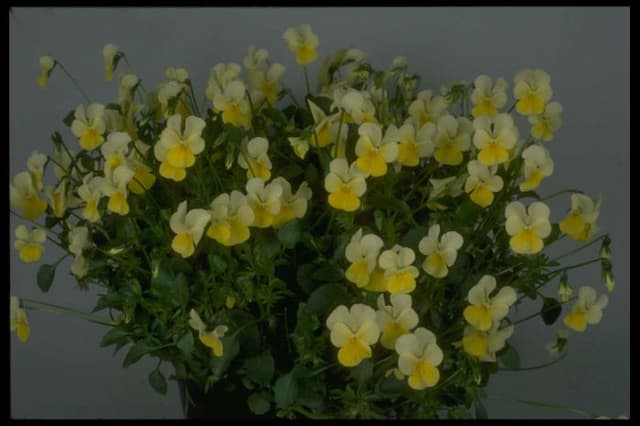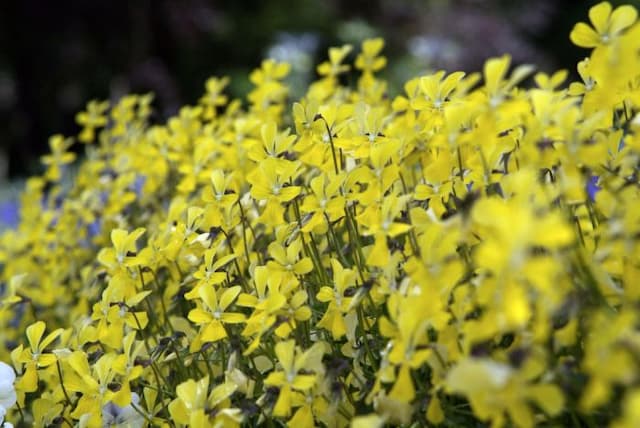Jackanapes pansy Viola 'Jackanapes' (Va)

ABOUT
Viola 'Jackanapes' is a distinctive plant widely admired for its charming flowers. The blooms are particularly striking with an unusual combination of colors. The petals typically showcase a deep blue or purple hue with a bold-faced center that is often a contrasting yellow or white. This creates a dramatic and eye-catching pattern that resembles a cheerful face looking up from the foliage. The leaves of this plant are of a medium green color, providing a lush background that makes the flowers stand out even more. They are generally heart-shaped with slightly serrated edges, forming a dense, low-growing mound. This neat foliage spreads out in a tufted fashion, creating a full and verdant presence in the garden. The plant itself is known for being a generous bloomer. During its flowering season, it can become quite a spectacle with an abundance of these colorful blossoms that are evenly distributed across the greenery. Each individual flower is a work of art, with delicate velvety petals that are soft to the touch. Viola 'Jackanapes' adds a delightful splash of color to any setting, be it a container, a rock garden, or as edging along pathways. This plant is not only recognized for its delightful appearance but also for its ability to bring a whimsical touch to the landscape, resembling a flock of tiny, exotic birds nestled among the greenery.
About this plant
 Names
NamesFamily
Violaceae
Synonyms
Jackanapes Viola, Tricolor Viola, Pansy Viola, Johnny Jump Up
Common names
Viola 'Jackanapes'
 Toxicity
ToxicityTo humans
The Viola 'Jackanapes', commonly known as Pansy, generally is not considered to be toxic to humans. These plants are often grown for their colorful flowers and are sometimes even used as edible garnishes in culinary dishes. That said, any plant material can potentially cause reactions in sensitive individuals or when consumed in large quantities. However, typical symptoms of plant poisoning like stomach ache, vomiting, or diarrhea are not commonly associated with the Pansy when ingested in small, reasonable amounts.
To pets
Pansies are generally considered non-toxic to pets such as dogs and cats. They are often grown for their attractive, colorful flowers and do not pose a significant risk of poisoning if pets nibble on them. As with any non-food plant material, if a pet ingests a large amount of Pansy, it could potentially cause mild gastrointestinal discomfort or an upset stomach, but serious toxicity or life-threatening symptoms are not expected.
 Characteristics
CharacteristicsLife cycle
Perennials
Foliage type
Evergreen
Color of leaves
Green
Flower color
Mixed
Height
0 feet 4-6 inches (10-15 cm)
Spread
0 feet 6 inches (15 cm)
Plant type
Herb
Hardiness zones
4
Native area
Europe
Benefits
 General Benefits
General Benefits- Ornamental Appeal: Viola 'Jackanapes', commonly known as pansy, adds vibrant colors to gardens, containers, and hanging baskets with its distinctive flowers.
- Extended Blooming Season: Pansies have a long flowering period, often blooming from spring through summer and even into fall in some climates.
- Low Maintenance: These plants are easy to care for, requiring minimal upkeep beyond regular watering and occasional deadheading to encourage more blooms.
- Cold Tolerance: Pansies are known for their ability to withstand cooler temperatures, making them a great choice for early spring and late fall plantings.
- Edible Flowers: Pansy flowers are edible and can be used to add a colorful garnish to salads, desserts, and drinks.
- Attracts Pollinators: While not their primary function, pansy flowers can attract butterflies, providing a small contribution to local pollinator populations.
- Versatile Design: Pansies are suitable for a variety of garden designs and can be planted in borders, beds, and as ground cover, depending on the gardener's creative vision.
- Quick Growth: Pansies typically germinate and grow quickly, offering rapid gratification in garden spaces and pots.
 Medical Properties
Medical Properties- This plant is not used for medical purposes.
 Air-purifying Qualities
Air-purifying QualitiesThis plant is not specifically known for air purifying qualities.
 Other Uses
Other Uses- Viola 'Jackanapes' can be used as a natural dye for fabrics, giving them a light green to yellow hue when the flowers are used in the dyeing process.
- The leaves of the pansy can serve as a mild laxative for pets like rabbits when a small amount is added to their diet.
- Ink made from pansy petals offers a unique, temporary writing fluid for artistic projects or calligraphy.
- Pansy petals can be infused in water to create a fragrant rinse for softening and adding a gentle scent to linens.
- When frozen into ice cubes, pansy blooms add an ornamental touch to cold beverages during special events.
- The plant can be used as a natural pH indicator, as the flowers change color depending on soil acidity or alkalinity.
- Pressed pansy flowers make for decorative bookmarks or can be laminated to create unique window hangings that catch the sunlight.
- Edible pansy flowers can be crystallized with sugar and used as an elegant garnish for desserts and cakes.
- Pansies can be planted as companion plants in vegetable gardens to attract beneficial insects and deter certain pests.
- Crafted into a floral perfume by distilling petals, pansies can provide a subtle fragrance for homemade perfumes or scented sachets.
Interesting Facts
 Feng Shui
Feng ShuiThe Pansy is not used in Feng Shui practice.
 Zodiac Sign Compitability
Zodiac Sign CompitabilityThe Pansy is not used in astrology practice.
 Plant Symbolism
Plant Symbolism- Innocence: Due to their delicate appearance, pansies like Viola 'Jackanapes' are often associated with innocence and purity.
- Thoughtful reflection: The pansy's name is thought to derive from the French "pensée," meaning thought, reflecting the flower's use as a symbol for remembrance and contemplation.
- Love: In the language of flowers, pansies are linked to the notion of love or admiration, making them a common gift among loved ones.
- Free-thinking: The diverse and vibrant colors of pansies like Viola 'Jackanapes' represent free thought and intellectual curiosity.
 Water
WaterPansies need to be watered regularly to ensure the soil stays moist but not waterlogged. It's best to water them deeply once a week with about 1 gallon of water per square foot of soil, depending on the weather conditions and soil type. In hotter, dryer periods, you might need to water them twice a week. Always check the soil moisture by sticking your finger an inch down into the soil; if it's dry at that depth, it's time to water. Avoid overhead watering to reduce the risk of leaf diseases and instead water at the base of the plant.
 Light
LightPansies prefer a spot where they can receive full to partial sunlight. They thrive in areas where they can get at least 6 hours of direct sunlight each day. However, in regions with very hot summers, providing some afternoon shade will help protect them from the intense heat.
 Temperature
TemperaturePansies are cool-weather flowers that can survive temperatures as low as the mid-20s in Fahrenheit for short periods. The ideal temperature range for growing pansies is between 40°F and 60°F. They can tolerate frosts and short periods of cold, making them excellent for fall and spring planting, but prolonged exposure to temperatures above 80°F can be detrimental to their health.
 Pruning
PruningPruning pansies involves deadheading, which means removing spent flowers to encourage more blooming. This should be done regularly throughout the blooming season. Additionally, lightly trim back leggy stems to maintain a bushy, attractive shape. The best time for pruning is in the late evening or on cloudy days to prevent stress on the plants.
 Cleaning
CleaningAs needed
 Soil
SoilThe best soil mix for Pansies (Viola 'Jackanapes') should be rich, well-draining, and have a slightly acidic to neutral pH of 6.0 to 7.0. A combination of one-third potting soil, one-third compost, and one-third perlite or vermiculite will create an ideal growing environment.
 Repotting
RepottingPansies, like Viola 'Jackanapes', should be repotted annually in the spring, especially if they were grown in containers. This will provide them with fresh soil and more space to grow and prevent them from becoming root-bound.
 Humidity & Misting
Humidity & MistingPansies prefer moderate humidity levels; however, they are adaptable to a wide range of conditions as long as their soil moisture needs are met and the air circulation is good. Viola 'Jackanapes' does not require high humidity environments.
 Suitable locations
Suitable locationsIndoor
Place in bright, indirect light and keep soil moist.
Outdoor
Plant in partial sun, shelter from harsh elements.
Hardiness zone
4-8 USDA
 Life cycle
Life cycleViola 'Jackanapes', commonly known as Pansy 'Jackanapes', begins its life cycle as a seed, typically sown in the spring or autumn in temperate climates. Upon germination, seedlings emerge and develop into juvenile plants with characteristic heart-shaped leaves and begin to form a compact, bushy growth habit. As the plant matures, it produces distinctive flowers that feature a unique combination of colors, often with a mix of purple, yellow, and blue hues, and a characteristic 'face' marking in the center. After pollination by insects, the flowers produce seeds, completing the reproductive cycle. Pansies are short-lived perennials but are often grown as annuals or biennials, with a life span that usually spans one growing season to the next, during which they may continue to bloom if conditions are favorable. As temperatures rise in the summer or as the plant ages, it can become leggy and may require rejuvenation by pruning or replacement through reseeding.
 Propogation
PropogationPropogation time
Spring to Summer
The Viola 'Jackanapes', commonly known as the 'Jackanapes Pansy', is typically propagated by seed. The most popular method for propagating pansies is to sow the seeds indoors during late winter, about 10 to 12 weeks before the last frost date. The seeds need to be thinly spread over moist seed-starting mix in a shallow tray, and then lightly covered with additional mix or vermiculite. The trays should be placed in a bright, warm location at approximately 65 to 70 degrees Fahrenheit (18-21 degrees Celsius), and the soil must be kept slightly moist but not soggy. Germination generally occurs in 1 to 2 weeks. Once seedlings have developed their first true leaves, they can be transplanted into individual pots or cell packs to grow on until they are large enough to be moved to their final outdoor location after the danger of frost has passed.









